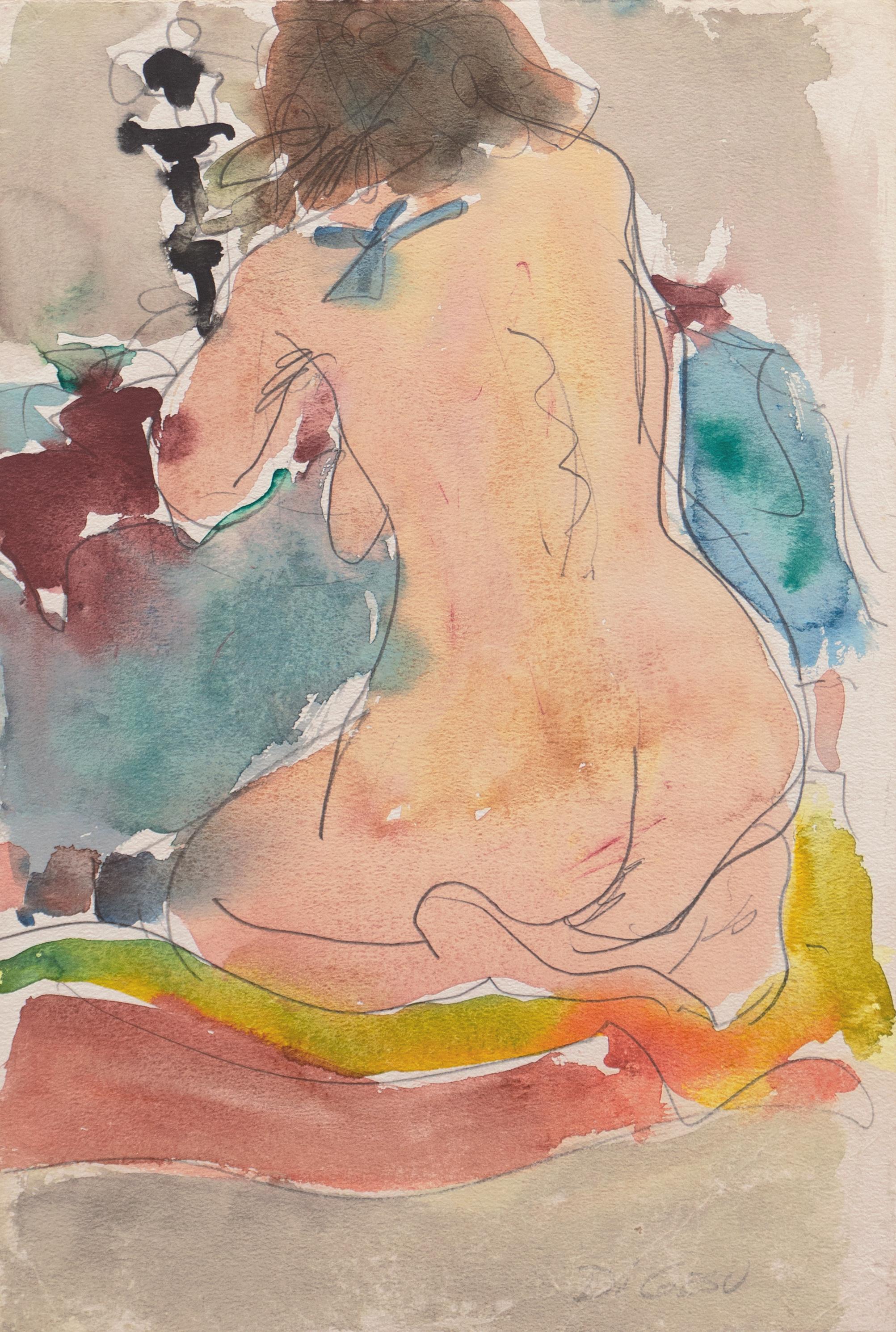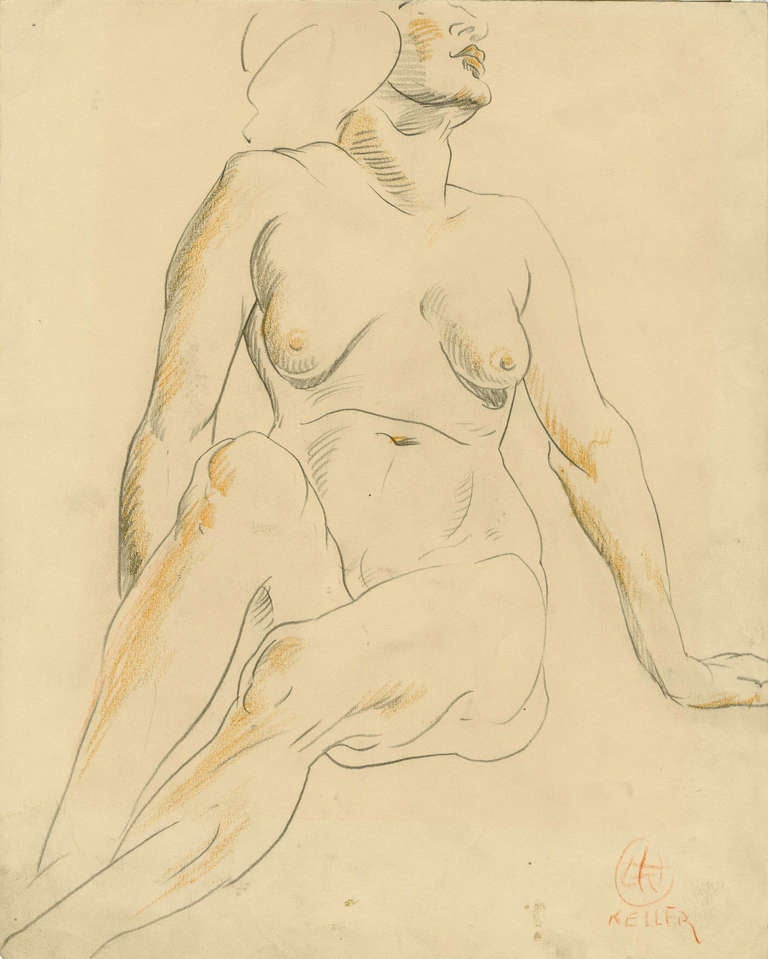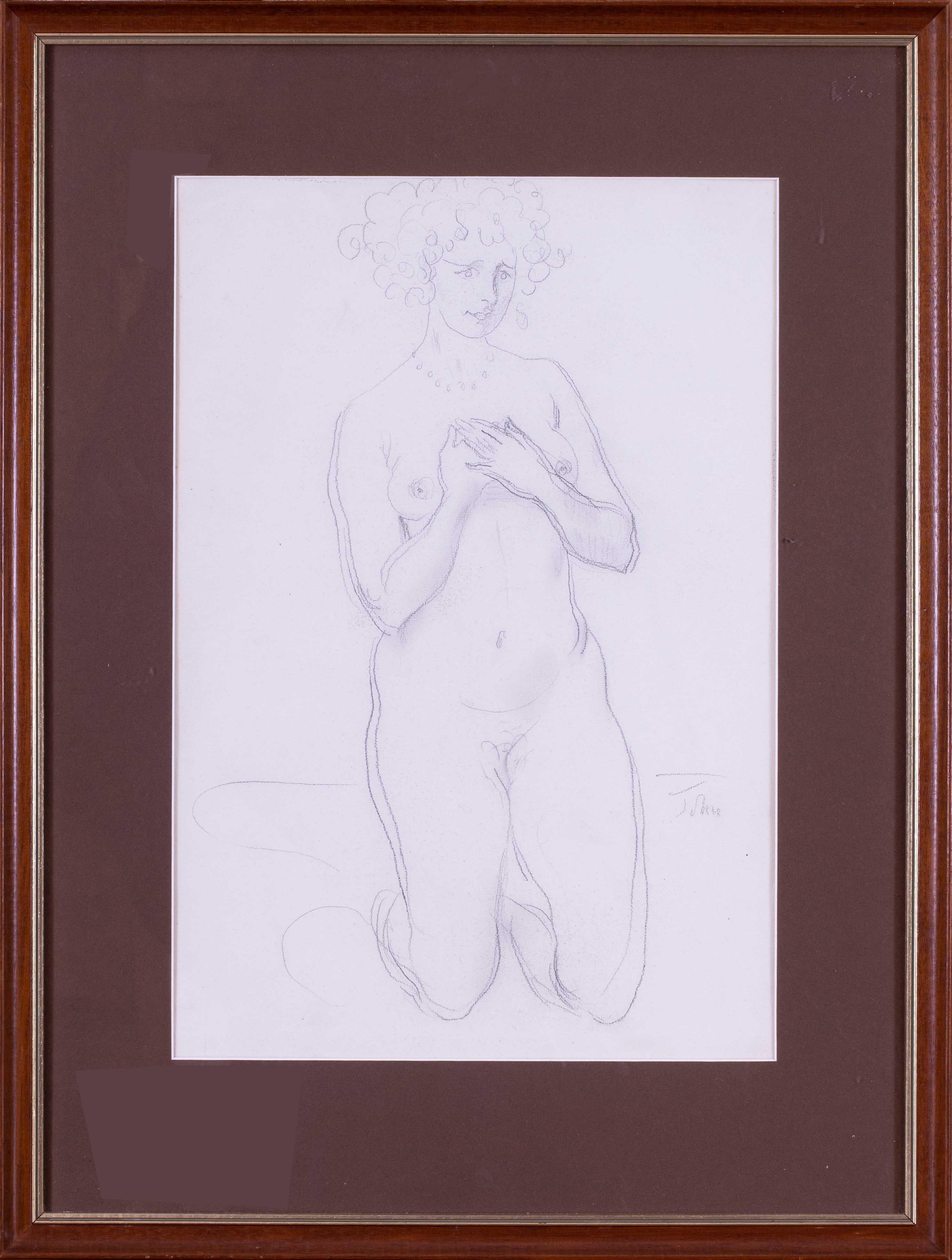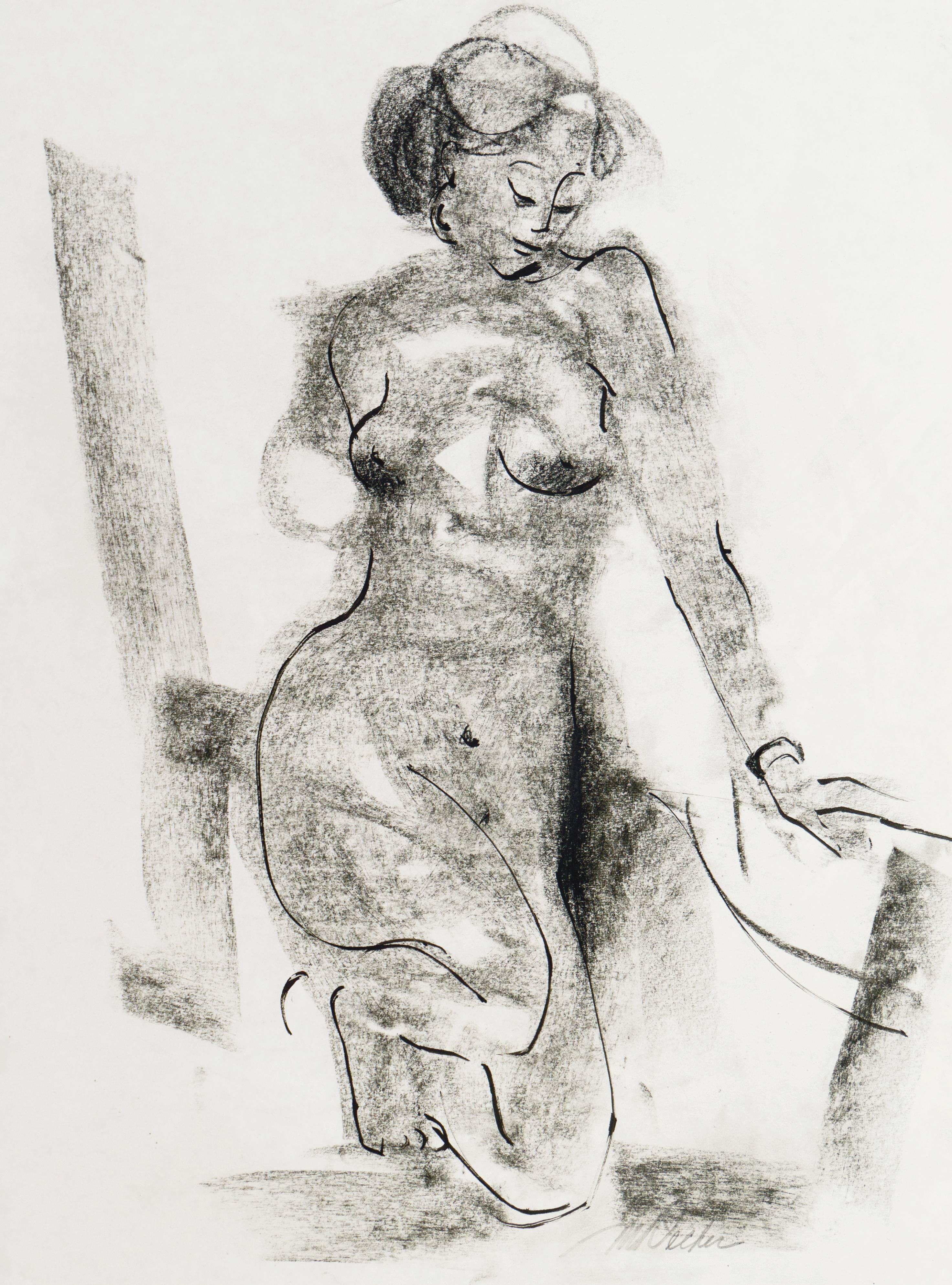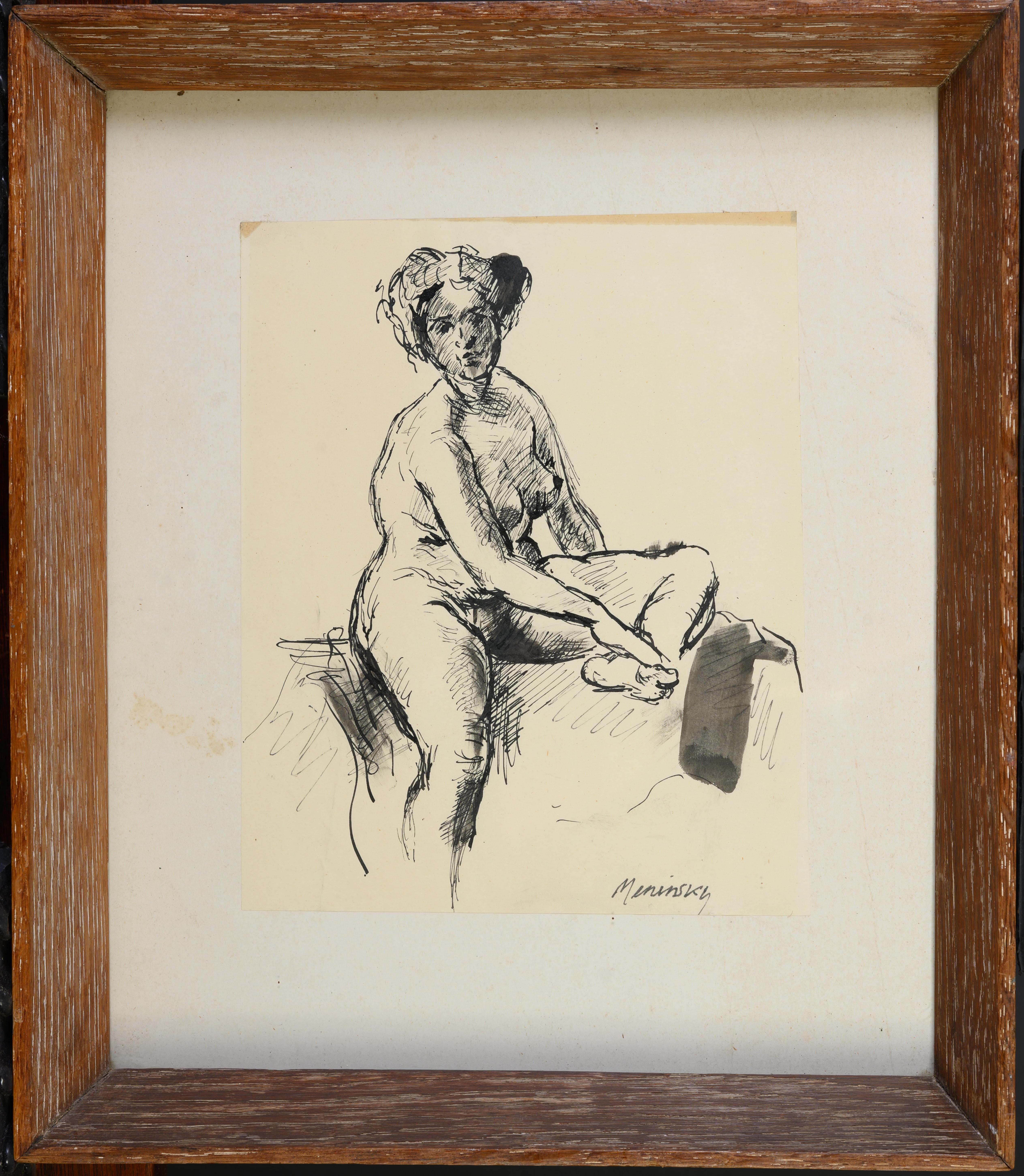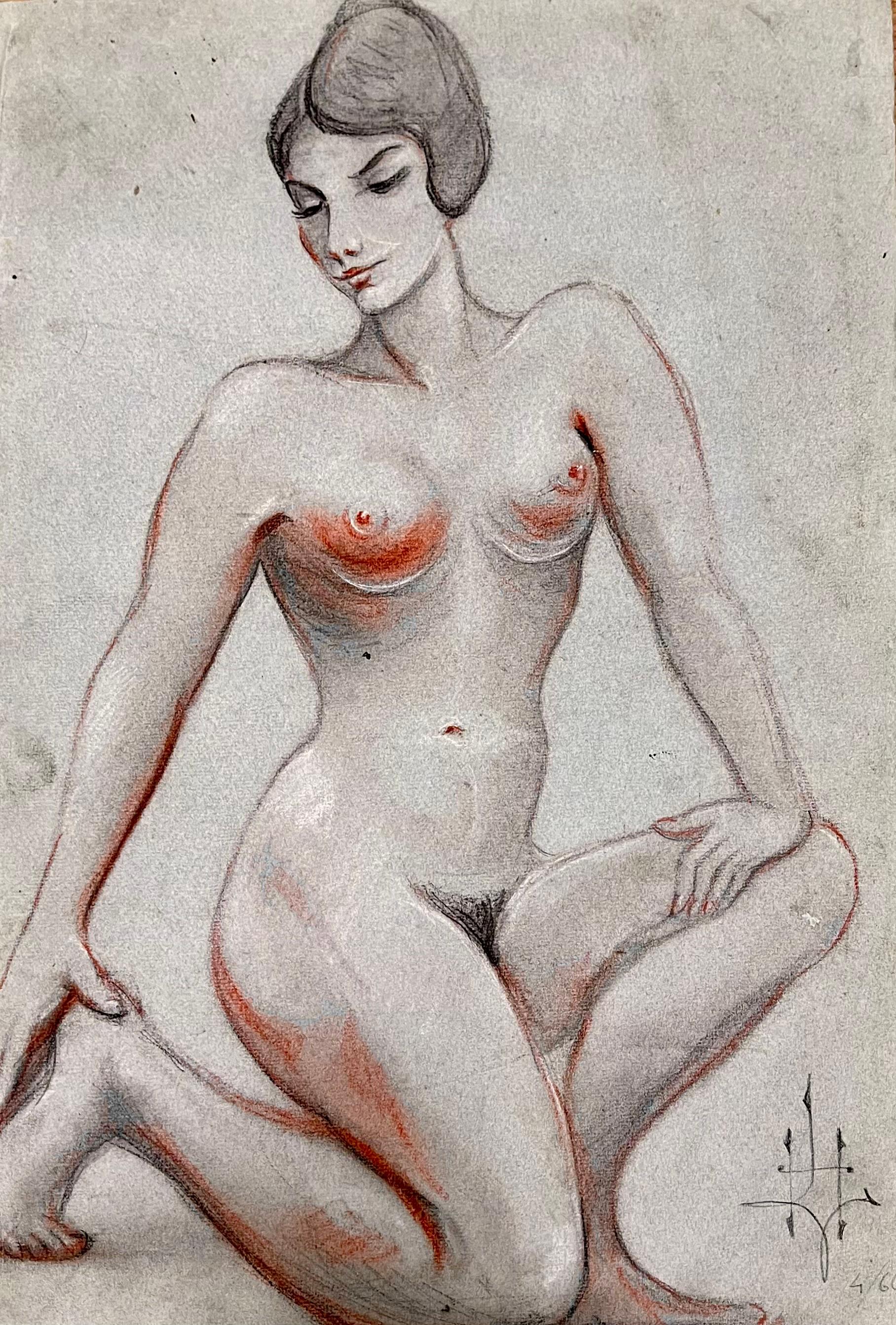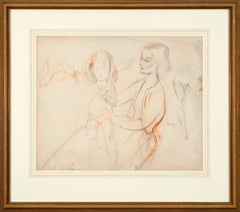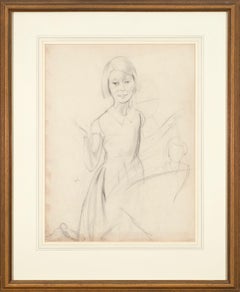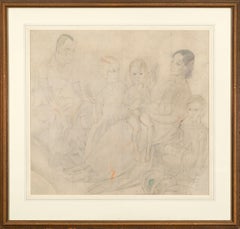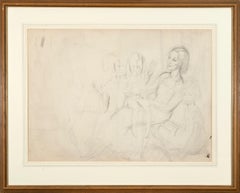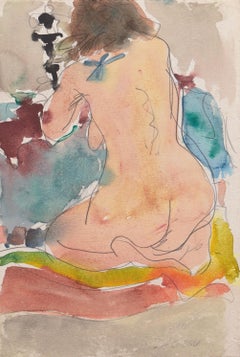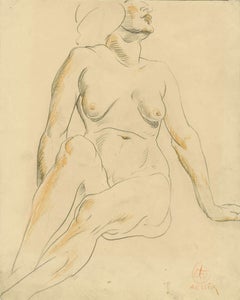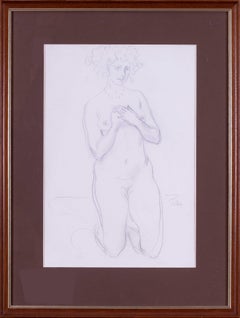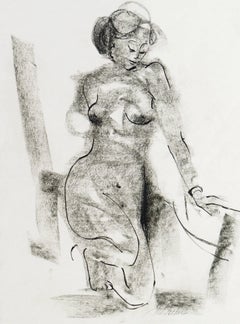Items Similar to Kneeling Nude, Study for The Maidens
Want more images or videos?
Request additional images or videos from the seller
1 of 11
Bernard Fleetwood-WalkerKneeling Nude, Study for The Maidens1932
1932
$1,907.81
£1,400
€1,635.56
CA$2,620.42
A$2,929.95
CHF 1,536.88
MX$35,488.76
NOK 19,400.12
SEK 18,328.42
DKK 12,207.83
About the Item
Bernard Fleetwood-Walker RA RWS (1893-1965)
Kneeling Nude, Study for The Maidens, c. 1932
Graphite, chalk and wash on paper
46.1 x 18.6 cm.; (within frame) 57.2 x 33.2 cm.
Provenance:
Bequeathed by the artist to his second wife, Dr Peggy Frazer;
Marion Phipps, Phipps Company Ltd., Mathon Court, Worcestershire;
Ma San Auction, Bath, 22 February 2024, lot 373;
Private Collection, United Kingdom.
Resting on her knees, a young lady draws a comb or brush through thick cropped hair, and gazes outward in contemplation. Her slender frame is pinched at the waist by the negative space of a pale blue wash, delineated by a firm line that draws her form out from the paper with a delicate sculptural effect. This stony curvature is achieved with graphite hatching throughout, and a measured wash in the darker areas. By contrast, a touch of chalk heightens her left knee and extends the depth with successful effect. The drawing is almost certainly a study for the dark-haired figure in The Maidens (1932), which depicts two nude women kneeling in a forest landscape. Further to being modelled exactly alike in form, with corresponding shadows across the chest and stomach, material similarities include the touch of chalk which heightens the left kneecap – directly comparable to chalk highlights on other known preparatory drawings. Kneeling nudes were a recurrent focus of Fleetwood-Walker’s more sensual compositions, and the sitters were often depicted brushing their hair or engaging in other forms of personal grooming. The drawing was previously in the collection of Fleetwood-Walker’s second wife, Dr Peggy Frazer, presumably inherited upon the artist’s death in 1965. It was afterwards acquired by Marion Phipps, of Phipps Company Ltd.
Bernard Fleetwood-Walker was born Birmingham in 1893, a twin and one of five children of William Walker and Electra Amelia Walker. Fleetwood-Walker’s father was an electrical engineer and co-inventor of the so-called Walker-Wilkins Patent Non-Polarising Voltaic Battery, which required cheaper chemicals and meant reduced costs in the running of engines and household lighting. Electra Amelia Walker (née Varley) was a granddaughter of the 19th century watercolourist Cornelius Varley FRSA (1781-1873), who together with his brother John Varley had founded the Royal Watercolour Society in 1804. Fleetwood-Walker was educated at Barford Street School and King Edward VI Five Ways School, before training as a modeller and metalworker, furthering his studies at Birmingham School of Arts and Crafts, and later in London and Paris.
Fleetwood-Walker served as a sniper during the First World War in the Artist’s Rifles, a volunteer light infantry formed in 1859 with a historic association with artists, musicians, and writers. Wounded and gassed in combat, Fleetwood-Walker continued drawing and painting where he could: in Christmas 1918, he decorated the walls of a warehouse in Auberchicourt being used as a mess hall with a mural, made up of dry colours and the glutinous remains of porridge. Upon his return to England, he exhibited his first work at the Royal Birmingham Society of Art (RBSA) in 1919, and in 1920 married Marjorie White, who had also studied at the School of Arts and Crafts. The couple would have two sons, Colin and Guy. He taught for some 10 years at King Edward’s Grammar School, Ashton, and left in 1929 to teach at Birmingham School of Arts and Crafts. After the death of his first wife, Walker re-married in 1939 to the doctor Peggy Frazer, who outlived the artist and to whom the present work passed.
Fleetwood-Walker held a solo exhibition at the Ruskin Gallery, Birmingham, and between 1925-65 (save 1929), exhibited in every Summer Exhibition of the Royal Academy, being elected a Royal Academician in 1956. He showed a total of 147 works at the RA during his lifetime. Regular exhibitions included those of the Royal Watercolour Society (RWS), New English Art Club (NEAC), Royal Society of Portrait Painters (RP), and RBSA. Fleetwood-Walker was proud to be the only Royal Academician from Birmingham who still lived in the city, and was elected as President of the RBSA in 1950. Around the same time, he was elected to the RWS, founded by his great-grandfather Cornelius Varley – satisfying a condition in Varley’s will that his studio collection be inherited by the next family member to be a member of the society. Later in his career he won a silver medal at the Paris Salon, and after his retirement from teaching in Birmingham he moved to Chelsea in 1951 to dedicate more time to his students at the Royal Academy Schools, where he had been appointed Assistant Keeper. Upon his death in 1965, a memorial exhibition was held in Birmingham.
- Creator:Bernard Fleetwood-Walker (1893 - 1965, British)
- Creation Year:1932
- Dimensions:Height: 22.52 in (57.2 cm)Width: 13.08 in (33.2 cm)
- Medium:
- Movement & Style:
- Period:
- Condition:The work is in good and stable condition. Light marks throughout, commensurate with age and having been stored within the artist's studio.
- Gallery Location:Maidenhead, GB
- Reference Number:Seller: Bernard Fleetwood-Walker1stDibs: LU2820215587042
About the Seller
No Reviews Yet
Vetted Professional Seller
Every seller passes strict standards for authenticity and reliability
Established in 2024
1stDibs seller since 2024
Typical response time: 1 hour
- ShippingRetrieving quote...Shipping from: Maidenhead, United Kingdom
- Return Policy
Authenticity Guarantee
In the unlikely event there’s an issue with an item’s authenticity, contact us within 1 year for a full refund. DetailsMoney-Back Guarantee
If your item is not as described, is damaged in transit, or does not arrive, contact us within 7 days for a full refund. Details24-Hour Cancellation
You have a 24-hour grace period in which to reconsider your purchase, with no questions asked.Vetted Professional Sellers
Our world-class sellers must adhere to strict standards for service and quality, maintaining the integrity of our listings.Price-Match Guarantee
If you find that a seller listed the same item for a lower price elsewhere, we’ll match it.Trusted Global Delivery
Our best-in-class carrier network provides specialized shipping options worldwide, including custom delivery.More From This Seller
View AllStudy for Mr and Mrs R. H. Butler and Their Daughters
Located in Maidenhead, GB
Bernard Fleetwood-Walker RA RWS (1893-1965)
Study for Mr and Mrs R. H. Butler and Their Daughters, c. 1932
Graphite and coloured graphite on paper, mounted to card
Signed centre right
42.6 x 53 cm.; (within frame) 66.7 x 75.7 cm.
Provenance:
The artist’s studio, 1965 (no. 521);
Private Collection, United Kingdom.
Dated to c. 1932, the present drawing belongs to a series of preparatory studies for Mr and Mrs R. H. Butler and Their Daughters (1932), a large family composition...
Category
1930s Post-Impressionist Portrait Drawings and Watercolors
Materials
Watercolor
Study for Mr and Mrs R. H. Butler and Their Daughters
Located in Maidenhead, GB
Bernard Fleetwood-Walker RA RWS (1893-1965)
Study for Mr and Mrs R. H. Butler and Their Daughters, c. 1932
Graphite on paper, mounted to card
Signed centre left
53 x 42.8 cm.; (within frame) 77.6 x 62.8 cm.
Provenance:
The artist’s studio, 1965 (no. 523);
Private Collection, United Kingdom.
Dated to c. 1932, the present drawing belongs to a series of preparatory studies for Mr and Mrs R. H. Butler and Their Daughters (1932), a large family composition...
Category
1930s Post-Impressionist Portrait Drawings and Watercolors
Materials
Watercolor
Study for Mr and Mrs R. H. Butler and Their Daughters
By Bernard Fleetwood Walker
Located in Maidenhead, GB
Bernard Fleetwood-Walker RA RWS (1893-1965)
Study for Mr and Mrs R. H. Butler and Their Daughters, c. 1932
Graphite, coloured graphite and wash on paper, mounted to card
64.5 x 74.5 cm.; (within frame) 87.4 x 91.8 cm.
Provenance:
The artist’s studio, 1965 (no. 525);
Private Collection, United Kingdom.
Dated to c. 1932, the present drawing belongs to a series of preparatory studies for Mr and Mrs R. H. Butler and Their Daughters (1932), a large family composition...
Category
1930s Post-War Portrait Drawings and Watercolors
Materials
Watercolor
Study for Mr and Mrs R. H. Butler and Their Daughters
By Bernard Fleetwood Walker
Located in Maidenhead, GB
Bernard Fleetwood-Walker RA RWS (1893-1965)
Study for Mr and Mrs R. H. Butler and Their Daughters, c. 1932
Graphite on paper, mounted to card
55.5 x 77.7 cm.; (within frame) 80.1 x 99.8 cm.
Provenance:
The artist’s studio, 1965 (no. 524);
Private Collection, United Kingdom.
Dated to c. 1932, the present drawing belongs to a series of five known preparatory studies for Mr and Mrs R. H. Butler and Their Daughters (1932), a large family composition...
Category
1930s Post-War Portrait Drawings and Watercolors
Materials
Watercolor
Patricia
Located in Maidenhead, GB
R. Lang Thomas (British, 20th century)
Patricia, 1947
Graphite on paper
Signed and dated lower right
34.4 x 26.8 cm.; (within frame) 56 x 47.5 cm.
Provenance:
The Chelsea Art Society;
Private Collection, United Kingdom.
Exhibition history:
The Chelsea Art Society, 1947
In attractive side profile, a young lady rests her gaze at a gentle distance, her lips pursed...
Category
1940s Post-War Portrait Drawings and Watercolors
Materials
Graphite
Cinder
Located in Maidenhead, GB
Joel Tomlin (b. 1969)
Cinder, 2004
Oil on linen
Signed and titled verso
183 x 157 cm.
Provenance:
Joel Tomlin;
MW Projects, London, 2004;
Permanent Collection, Saatchi Gallery;
Chri...
Category
Early 2000s Contemporary Landscape Paintings
Materials
Oil
$7,086 Sale Price
20% Off
You May Also Like
'Kneeling Nude', Louvre, Académie Chaumière, LACMA
By Victor Di Gesu
Located in Santa Cruz, CA
'Kneeling Nude', Louvre, Académie Chaumière, LACMA
Signed lower right, "Di Gesu" for Victor di Gesu (American, 1914-1988) and painted circa 1955.
Watercolor nude showing a woman kn...
Category
1950s Post-Impressionist Nude Drawings and Watercolors
Materials
Paper, Watercolor, Graphite
Untitled (seated female nude)
By Henry Keller
Located in Fairlawn, OH
Seated Femake Nude
Graphite and chalk on tan paper, c. 1920
Signed "Keller" and signed again with the artist's initials in a cypher
A finished life drawing most probably exhibited at...
Category
1920s American Modern Nude Drawings and Watercolors
Materials
Graphite
Augustus John, British, drawing of a kneeling nude, pencil on paper
By Augustus Edwin John
Located in Petworth, West Sussex
Augustus John (British, 1878 – 1961)
Kneeling nude
Pencil on paper
Signed ‘John’ (lower right)
19 x 13 in. (48.3 x 33 cm.)
Provenance: Bonhams, 26th March 2025
Category
20th Century Post-Impressionist Nude Drawings and Watercolors
Materials
Paper, Pencil
'Kneeling Nude', American Modernist Graphite Figural Study
By Michael Decker
Located in Santa Cruz, CA
Signed lower right, "M. Decker" for Michael Decker (American, 20th Century) and created circa 1975.
An elegant graphite and india ink figural study showing a young woman kneeling an...
Category
1970s Impressionist Nude Drawings and Watercolors
Materials
Paper, Charcoal, Ink
Seated nude
By Bernard Meninsky
Located in Douglas, Isle of Man
Bernard Meninsky 1891-1950, was a British painter, draughtsman and teacher. He painted figures, landscapes in oil and watercolour, he attended the Royal College of Art and the Acade...
Category
Early 20th Century Portrait Drawings and Watercolors
Materials
Paper, Ink
1960's Original French Pastel Sketch Nude Kneeling Nude Study Poised Elegance
Located in Cirencester, Gloucestershire
Nude Lady Study
French School, circa 1960's
chalk and pastel on artists paper, unframed
stamped
size: 18 x 12.5 inches
condition: very good and ready to be enjoyed
provenance: priv...
Category
Mid-20th Century Modern Nude Paintings
Materials
Chalk, Pastel
